Oakland’s scavengers
Garbage service in Oakland started 100 years ago when scrappy Italian immigrants began collecting trash from backyards. This business bloomed into a multi-million dollar industry with roots at the intersection of 51st and Telegraph Avenue. Find out more below and listen to oral histories of the men who were part of this community.
By Sierra Filucci
Trash to Treasure:
The History of the Oakland Scavenger Company
Louis Alberti sits with his back against the wall, a pile of black and white photographs spread out in front of him. He points to a picture of a man standing on the back of an old garbage truck, trash can hooked over his shoulder. “This is how we used to carry the barrels,” he says. As he pages through the photos, talking about horse-drawn carriages and recycling, a group of well-dressed folks begins to gather around the table. “Aren’t they wonderful?” says Rose Cosso, pointing to a photo of four men standing in front of an ancient garbage truck, with wide grins and cocky poses. “They worked 7 days a week. They never, ever complained,” she says.
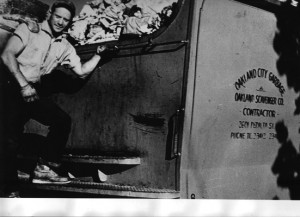
Historical photo of an Oakland Scavenger.
At tonight’s gathering of the Ligure Club, an 80-year-old social club for men with family ties to the northern Italian region of Liguria, nearly everyone has some connection to the Bay Area’s history of garbage collection.
Alberti’s uncle was one of thousands of Italians who immigrated to the Bay Area around the turn of the century, many of whom got into the garbage business. “What they tell me is my uncle came to San Francisco in 1905 and there was an earthquake the next year, so he took his team of horses on a barge and came to Oakland and started picking up garbage,” he says.
But Alberti’s uncle wasn’t the only one with this moneymaking idea. “There was several different Italian families picking up garbage, and they were always fighting,” says Alberti. “So they decided, in 1915 or 16, to quit fighting and start a co-op.”
This co-op eventually became the Oakland Scavenger Company. At the same time in San Francisco, two similar companies emerged from the hundreds of independent operators there to form the Scavenger’s Protective Association and Sunset Scavenger Company.
Garbage companies became lifelines for Italian immigrants, who arrived in steady numbers from the mid-1800s until 1924 when stricter immigration laws took effect. “It was really a magnet,” says Robert Biasotti, a third-generation garbage man as he sits in a conference room at Waste Management’s Davis Street Transfer Station in San Leandro, where he now works. Like today, he says, immigrants would arrive with little more than a name in their pocket. More established immigrants would take them in and point them toward a job that required little English or training. “So many people became involved in garbage that way,” Biasotti says.
These new immigrants were doing the work no one else wanted to do, says Joe Brignole, a longtime North Oakland businessman who traces his family’s arrival in California to the 1850s. And though few were educated, the Oakland Scavengers created something valuable and lasting. “From honesty, hard work and intelligence — and they were intelligent — they created this huge enterprise,” he says. Their innovative efforts included recycling and composting in the 1920s — way before anyone else was doing this. “The paper went one place,” Brignole says. “They had ranches with hogs and they would feed them stuff out of the garbage. They had a glass facility.”
Oakland Scavenger grew to include several auxiliary businesses like the Bay City Bottle Supply Company, where workers would wash and sterilize bottles and sell them to wineries, and a rag company where cloth was bundled and sold to petroleum companies in Richmond and Rodeo. Alberti says the company once owned 13,000 hogs who noshed on residential and commercial kitchen waste.
John Cosso, looking sharp in a black turtleneck and blazer, sits across from Alberti and his photos and recalls his first years with Oakland Scavenger in the early 1950s. “I remember getting up early, going out in the driving rain, picking up trash, putting it into the barrel, taking the barrel and putting it on my back and climbing the seven steps to heaven and putting it into the truck,” he says. Cosso followed two brothers and two brothers-in-law into the company. He worked in several divisions and ended up as manager of the Davis Street Transfer Station. He retired in 1993.
Alberti’s photos help memories unfurl for Cosso and many others who stop by to admire the pictures, which were in danger of being thrown away after Waste Management bought the company in 1986. Many of the Ligure Club members grew up in the Temescal neighborhood, which was the center of the Italian-American community in Oakland beginning in the early 1900s. Before that, many lived in San Francisco and West Oakland, but the 1906 earthquake shifted populations around, bringing San Francisco’s Italians across the bay, and African Americans to West Oakland.
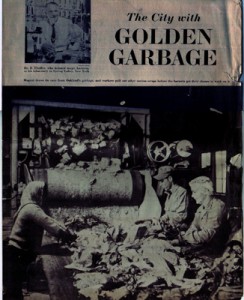
Cover of “The City with Golden Garbage,” Collier's Weekly Magazine, May 31, 1952. Courtesy of Robert Biasotti.
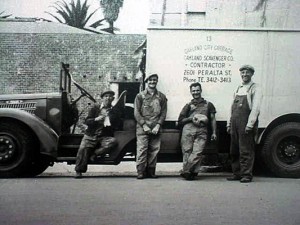
De Vincenzi's father and his old coworkers.
The area around 51st St. and Telegraph Ave. became Oakland’s “Little Italy” commercial hub. “There was just all kinds of Italian small businesses there and that’s where we mostly patronized,” says Alberti, who recalls the meat market that went up at the intersection after the Key System’s car barn was torn down, as well as the furniture store, the barber, the paint shop, the hardware store – all owned by Italian immigrants. “We were a really tight neighborhood.”
Though most remnants of Little Italy have long since disappeared, two businesses continued to have an impact on the neighborhood through the present day. Until recently a Bank of America sat on the corner of 48th St. and Telegraph. The founder of the bank, originally called Bank of Italy, was A. P. Giannini, whose business took off after the 1906 earthquake when he reportedly set up shop at the Embarcadero and lent to many Italian immigrants whose homes and businesses had been destroyed by the post-quake fires. He opened a branch in the Temescal neighborhood, where he lent to and employed locals – Alberti’s cousin was a branch manager.
Genova Delicatessen – a popular sandwich shop with a growing frozen foods business – has been in the neighborhood since 1926. Originally the shop was at 4937 Telegraph Ave. until it moved to the Walgreens shopping center right at the intersection of 51st and Telegraph in 1997.
Dominic De Vincenzi came into the business in 1951, after working periodically with his father at Oakland Scavenger Company. In his office above the deli, De Vincenzi sits surrounded by duck hunting paraphernalia and family photos, including a picture of his father in front of an Oakland Scavenger truck with three other men. De Vincenzi almost went into the garbage business himself. “I tried it for about six months and then my mother threw my clothes away and wouldn’t let me go,” he says. “Because I’d come home and be exhausted. She said, ‘You’re not going to do this kind of business.’”
De Vincenzi, Alberti and many other children of garbage collectors went to school together in the Temescal neighborhood. Though neither man admits to feeling looked down upon for his family’s profession, Marian Gatti, whose father was a garbage collector and who still lives in the Temescal neighborhood remembers she and her friends being called “garbage pickers” by scornful children. She says a schoolteacher who complimented the work of garbage men in front of her childhood classroom was a rare antidote to the teasing.
But as De Vincenzi recalls, he was surrounded mostly by fellow children of garbage collectors, and spent his early days at various family members’ homes on weekends. “They’d go over to people’s houses on Saturday night and maybe play cards and they would have an accordion player there, and they would have a little dance,” he says smiling. “It was a nice time to be brought up.”
As the men and women at the Ligure Club assemble in the banquet hall to eat pesto tortellini and prime rib, Brignole steps up to the podium, and recounts the history of Italian-American social clubs like this one. “They were founded for the purpose of establishing centers, places where the Italian-American communities could gather in the spirit of friendship, dignity and joyful reunion, and places where the finest of Italian-American festivals and traditions could be enjoyed and exalted.”
Besides the Ligure Club, several other clubs provided a private place for Italian-Americans to socialize from the 1920s until today. The Colombo Club on Claremont Ave. near Telegraph Ave. was founded in 1920 to serve mostly quarry workers, and the Fratellanza Club, off San Pablo Ave. near the Berkeley border began in 1932. The Ligure Club once had a building on 48th St. and Telegraph, serving mostly garbage collectors, but now uses the Fratellanza building for dinners and bocce ball tournaments.
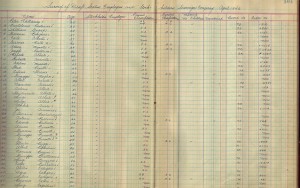
Excerpt of Oakland Scavenger Company employee and stockholder roster from April 1943. Courtesy of Robert Biasotti.
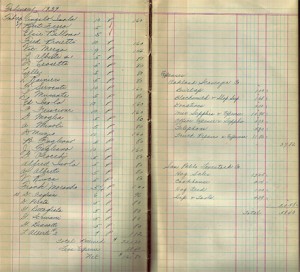
Excerpt of Oakland Scavenger Company expense ledger from Feb. 1939. Courtesy of Robert Biasotti.
In the early 1960s, the state completed construction of the Grove Shafter Freeway, also known as Highway 24, which ripped a swath through the Temescal neighborhood. The freeway took many homes, including Alberti’s, and came within feet of Gatti’s family complex on Claremont Ave. This construction, combined with extensive suburban development, drove many longtime Italian-American residents to places like Walnut Creek, where De Vincenzi now lives. Racial integration was also a factor in the dissolution of Temescal’s Little Italy. Between 1950 and 1960, Oakland’s African American population nearly doubled, echoing demographic and cultural shifts in urban centers throughout the country. Though the former Scavengers tread lightly on the subject of race, talking vaguely about “changes in society” during this era, clearly many felt uncomfortable with a more integrated neighborhood. De Vincenzi says that an altercation between one of his children and another neighborhood child was the deciding factor in his move to the suburbs.
As the Temescal neighborhood was changing, so was the Oakland Scavenger Company. Where the company was once exclusively Italian-American, the labor force had opened up to Latinos, African Americans and other ethnic groups during World War II. But while non-Italians were on the job, management was still Italians-only because of the company’s cooperative structure that awarded plum jobs only to shareholders.
“We were a private company and we just sold shares to Italians,” says Alberti. A few Latinos became partners too. “They looked Italian,” jokes Alberti. “We snuck ‘em in.” After the Civil Rights Act of 1964 the company changed its policies to accommodate the new law. Alberti says the company stopped selling shares and only allowed ownership to pass through a shareholder’s estate. This was an attempt to work within the law, but also to keep all non-Italians out of positions of power. Once a refuge from anti-Italian bias, the company was hauled into court in the late 1980s for discriminating against African American and Latinos. A judge ruled that the company broke the law by granting preferential treatment to shareholders, who were exclusively white, and awarded damages to some 300 current and former employees.
In the midst of this lawsuit, shareholders voted to sell the company to Waste Management. “As the older guys got older, we took a vote and the guys said let’s finish it,” Alberti says. “They were tired of the lawsuits.”
Biasotti was one of the younger shareholders at the time of the vote. “I think some of them maybe saw an attractive financial offer and said, ‘Gosh maybe it’s time,’” Biasotti says. “But it’s also part of what was happening in this country from a business point of view. Small companies were getting bought up by big companies.”
Shares that had cost between $10,000 and $40,000 were cashed in for approximately $750,000 through the sale. Many of the shareholders remained employees of Waste Management. Alberti stayed on for five more years. Biasotti remains the assistant district manager at the Davis Street Transfer Station along with district manager Jack Isola, who was also an Oakland Scavenger. These two men are the last remaining links to Oakland’s original garbage collectors.
Back in the Waste Management conference room, Biasotti looks at a white board scribbled with tonnage numbers, and grips an Oakland Scavenger ledger from the 1940s in his fist. He recalls a story his father told him from the Depression-era. “My dad was recently married and he would pray that they would call him to work on a Saturday because on Saturday he would get paid two dollars for the day and the older partners would buy you breakfast,” he says, leaning back in his office chair. “It’s ironic, I was thinking the other day, $2 for a day and the going rate now for a garbage man is $28 an hour. So that tells a lot about things that have changed.”
20 Comments
Leave a Comment
You must be logged in to post a comment.








[…] panorama of this Temescal intersection, with links to stories about the neighborhood’s long Italian history, its Eritrean immigrant community, and life behind the counter of Bakesale Betty’s and […]
I believe my great grandfather, Anthony Casazza, a northern italian immigrant started the Oakland Scavenger. His three sons were not interested in going into the business so my great grandfather then sold it to the family that runs it till this day. At least this is what I have been told. I was also told that Anthony Casazza founded the Colombo Club.
I have been doing some research on the history of OSC as my family including myself spanned employment over 100 years. My initial information shows that a Casazza was one of four founders in 1907.
Robert, my grandfather was Tony Dalcino. Please contact me when you can. I have so many pictures that I would love to share and to get some history. I have a picture and signature of Joe Biasotti. When you get a chance, thank you Jeff
Jeffrey: I was going thru information and saw your post of 4/26/15. I would like to talk to you and share those pictures.
Thanks
Mr. Biasotti,
Hello. I was looking up information on Oakland Scavenger’s history and found this lovely article. My late dad was hired by OSC in the late 70s to work in the company’s hazardous waste department. His name was John Sheahan and how he enjoyed working there! He was excited and proud to do the work but he also really enjoyed the people at Oakland Scavenger Company. I myself worked there a couple summers in the early 80s. It was a wonderful place with a real family business feel.
Anyway, I am happy you’re helping to preserve an important piece of Oakland history.
Regards,
Kate
I just recently stumbled upon this article, and told my Aunt about it.
She told me that Carlo Alberti, Luigi Alberti, and their father-in-law, Leonardo Vinci, were some of the people who helped start the Oakland Scavengers.
A number of my relatives, now mostly deceased, were partners in the Scavengers.
Leonardo Vinci was my great-grandfather.
My family lived in Temescal for many years, until most of us migrated out to Contra Costa County. I actually lived on Cavour Street in Temescal until 1955, when we moved to Walnut Creek.
My maternal grandfather, Charlie Garto, owned the Sportmen’s Corner bar on 47th & Telegraph, and my paternal grandfather Tony Ceragioli owned a produce market nearby.
My maternal grandmother, Alma (Charlie’s wife) was Carlo and Luigi’s sister-in-law, and one of Leonardo’s daughter
I have printed out a copy of the article to send to my Aunt.
Thanks so much for publishing this bit of Oakland history.
I remember Charlie Garto and his wife Alma! My grandfather, Nello Casazza used to bring me into The Sportsmen’s club when I was a little kid. My great grandfather, Anthony Casazza was one of the founders of Oakland Scavenger but his son, Nello (my grandfather) didn’t want to take over when his dad retired. My grandpa owned a hardware store on Telegraph Ave. for many years. Do you have a sister named Gina Ceragioli who lives in Walnut Creek? She is a good friend of mine
Yes, Stephanie, Gina is my cousin. That is so wonderful that you remember my Nonny Alma and Nono Charlie. My mom Chickie took us to Nono Charlie’s bar many times when we were kids.
I remember the name Casazza-I know my Lala Betty has mentioned it.
I think you and I are related.
We’re you at the Vinci Family reunion a couple of years ago?
My email is rceragioli1@att.net.
Richard, my grandparents lived on Cavour Street as well. My great grandfather owned his own scavenger company on Clairemont. I looked up your last name and a man named Anthony Ceragioli lived right next door to my grandparents. Was this your father or your grandfather? I am wondering if your family knew mine. My mother’s name was Karen Dogali she would have been born in 1952 my uncle was Daryl Dogali and he was a few years older. My grandparents were Gus and Hazel Dogali. Their address was 459 Cavour. Anthony Ceragioli lived at 461 Cavour street in the 1940 Census. I am assuming this was your grandfather. They had two sons living with them in 1940.
Yes, Nanette, Tony was my paternal grandfather. And, yes, my paternl grandparents lived at 461 Cavour, along with my Dad Mario and his brother, my Uncle Ray. I remember visiting my grandparents at that house as a boy, and playing in the backyard. Also, my Mom’s family lived nearby on Shafter, and then in 1948 I believe they moved to 5311 Boyd, a couple of blocks away. I only have my Mom’s sister left to ask about this stuff. Everyone else has passed away.
Did Bob ever get back to you about the history we are trying to put together? I am working with bob now to try and get as much in one place as we can to preserve the history of the scavengers.
My Email is jmperillo@gmail .com
thanks Joe
My grandfather was one of the original scavengers coming from Italy in 1906. My dad, Joe Navone , had the opportunity to take over my grandfathers share. His comment was “have you ever seen 200 Italians in one room trying to get anything accomplished?”. So he refused the share and in 1939 come over the Eastbay hills and started the Orinda Garbage Service and it remained in the Navone family until 1990. Its been quite a ride!
Hi George, Just wondering … is your mother Francis Ciraulo (may have spelling wrong) who had sisters named Rosie, Mary and Josie (who were all quite a bit older)?
Hello Gina, Yes Frances was my mother. She Passed away last September at the age of 99. A long and fruitful life. If you would like to compare notes, my email is below. Are you from the Turturici family from the Campbell-San Jose Area?
Hi George, I would love to connect. I have a great picture of your mother and father with extended family from probably the early 1950s (or late 1940s). My Aunt Angie (98) had the pictures in her possession and I scanned all of them. As I believe this site strips email addresses, you can find me on Facebook or can contact me at gturturici at comcast dot net. I am originally from Campbell.
My great grandpa, Carlo Isola, also arrived in 1906. They may have come over together. Great grandpa arrived right in the midst of the earthquake cleanup. There’s a famous picture of theee or four guys in the horse and buggy “truck” and Carlo is in the center. Cant remember the names of who else is on there with him. Great stories, that for sure! .
I would love a digital picture of that we are trying to put it together and it takes alot of work. I might already have it but it would be great.
Thanks
joe
So many great stories. My great grandfather, Carlo Isola and his brother, were also part of the original Oakland Scavenger in 1906 cleaning up after the earthquake. I have some great pics of them with horse and buggies in 1906. Those men truly earned their livings!
We are trying to build a new website with as many pictures and information that we can about the Oakland Scavenger company or as some remember was called the oakland garbage company from before the turn of the century. My Father was Aurelio Perillo who was a partner for 33 yrs with the Scavengers. I have recently acquired a ton of pictures from the early days of the company. I am working with others who are interested in putting this site together. The close of the company was quite tragic end for many and never had any closure. We would like to make it a group effort with many of the remaining people who remember anything we can use to make this happen. I am sure that we all have many pictures and input on how to make this happen. I found this site and there is alot of videos that reference the early and late days of the company. We have lost to many with lots of information and would love to make this a great site where you could go and download pictures and information about your past. I am not sure that this site will help us but any input would be appreciated. This is not a money making idea it would be for information only. My Email address is jmperillo@gmail .com.
Thank you
Joe Perillo